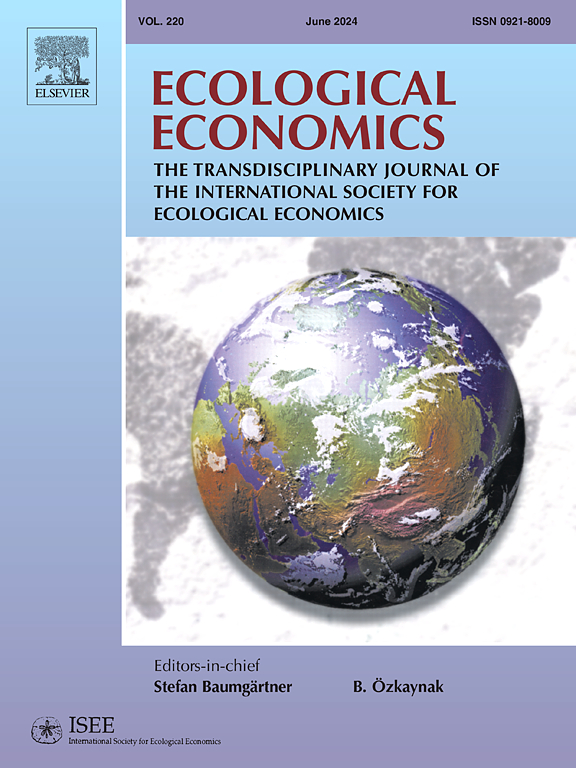碳巨人:探索欧盟工业二氧化碳排放前 100 强
IF 6.6
2区 经济学
Q1 ECOLOGY
引用次数: 0
摘要
我们利用《欧洲污染物排放和转移登记簿》、《欧盟交易日志》、人口网格和地区信息中的数据,分析了欧盟前 100 名工业二氧化碳排放者的排放量和相关损失。这些顶级排放者的排放量占欧盟二氧化碳总排放量的 19%、工业二氧化碳排放量的 39%、工业 SOx 和 NOx 排放量的三分之一以及工业 PM10 排放量的很大一部分。2017 年,有害共污染物的货币化损失在 200 亿至 670 亿欧元之间,共污染物和气候损失的总和在 920 亿至 2600 亿欧元之间。仅前 100 种污染物就将在几十年内耗尽欧盟的碳预算。前 100 强中有相当一部分企业对气候和共同污染物造成的损失超过了其所在地区整个工业部门所创造的经济价值,这表明监管严重不足。然而,前 100 强的碳排放量中有 27% 获得了欧盟排放交易系统的免费许可。许多排放大户都位于人口稠密地区,3.1% 的欧盟人口居住在碳巨人 10 公里范围内。我们的分析揭示了在研究和决策中解决主要排放者问题的极端重要性。本文章由计算机程序翻译,如有差异,请以英文原文为准。
Carbon Giants: Exploring the Top 100 Industrial CO2 Emitters in the EU
We analyze emissions and associated damages from the top 100 industrial CO2 emitters in the EU using data from the European Pollutant Release and Transfer Register, the EU Transaction Log, population grids, and regional information. These top emitters account for 19% of total EU CO2 emissions, 39% of industrial CO2 emissions, as well as a third of industrial SO and NO emissions, and a significant share of industrial PM10 emissions. In 2017, monetized damages of hazardous co-pollutants range from 20 to 67 billion Euros, and combined co-pollutant and climate damages amount to between 92 and 260 billion Euros. The top 100 alone would exhaust the EU’s carbon budget in a few decades. The joint climate and co-pollutant damages of a significant number of the top 100 exceed the economic value generated by the entire industry sector in their respective regions, indicating substantial underregulation. Yet the top 100 received free EU Emissions Trading System permits for 27% of their carbon emissions. Many top emitters are located in densely populated regions, with 3.1% of EU’s population living within 10 kilometers of a Carbon Giant. Our analysis reveals the critical importance of addressing major emitters in research and policymaking.
求助全文
通过发布文献求助,成功后即可免费获取论文全文。
去求助
来源期刊

Ecological Economics
环境科学-环境科学
CiteScore
12.00
自引率
5.70%
发文量
313
审稿时长
6 months
期刊介绍:
Ecological Economics is concerned with extending and integrating the understanding of the interfaces and interplay between "nature''s household" (ecosystems) and "humanity''s household" (the economy). Ecological economics is an interdisciplinary field defined by a set of concrete problems or challenges related to governing economic activity in a way that promotes human well-being, sustainability, and justice. The journal thus emphasizes critical work that draws on and integrates elements of ecological science, economics, and the analysis of values, behaviors, cultural practices, institutional structures, and societal dynamics. The journal is transdisciplinary in spirit and methodologically open, drawing on the insights offered by a variety of intellectual traditions, and appealing to a diverse readership.
Specific research areas covered include: valuation of natural resources, sustainable agriculture and development, ecologically integrated technology, integrated ecologic-economic modelling at scales from local to regional to global, implications of thermodynamics for economics and ecology, renewable resource management and conservation, critical assessments of the basic assumptions underlying current economic and ecological paradigms and the implications of alternative assumptions, economic and ecological consequences of genetically engineered organisms, and gene pool inventory and management, alternative principles for valuing natural wealth, integrating natural resources and environmental services into national income and wealth accounts, methods of implementing efficient environmental policies, case studies of economic-ecologic conflict or harmony, etc. New issues in this area are rapidly emerging and will find a ready forum in Ecological Economics.
 求助内容:
求助内容: 应助结果提醒方式:
应助结果提醒方式:


